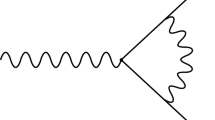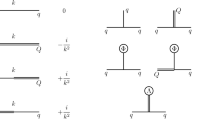Abstract
We give a brief review of the current understanding of renormalons of the static QCD potential in coordinate and momentum spaces. We also reconsider estimate of the normalization constant of the \(u=3/2\) renormalon and propose a new way to improve the estimate.




Similar content being viewed by others
Notes
If we denote the UV contribution to \(\delta E_\mathrm{US}\) which cancels the IR renormalon by \(\delta E_\mathrm{US}|_{\text {UV contr.}}=V_A^2(r;\mu ) r^2 \mathcal {O}(\mu )\), it should be \(\mu \) independent. To obtain Eq. (5), we use the fact that \(\mathrm{Im} \, V_S(r)_{\pm }|_{u_*=3/2} \propto V_A^2(r;\mu ) r^2 \mathcal {O}(\mu ) =V_A^2(r;\mu _0) r^2 \mathcal {O}(\mu _0)\) and then use Eq. (6). Note that \(\exp [-2 \int _{\alpha _s(\mu _0)}^0 \mathrm{d}x \, \gamma (x)/\beta (x)] \mathcal {O}(\mu _0)\) is \(\mu _0\) independent.
If the minimal sensitivity scale is not found in the range \(1/2< \mu r <5\), we treat \(\mu r=1\) as the minimal sensitivity scale.
The final error is estimated in this way in Ref. [15] and we follow it.
Rigorously speaking, \({d_n^f}^{u_* \mathrm{(asym)}} \propto (\mu ^2 r^2)^{u_*}\) does not exactly hold in general cases because \(c_{k, u_*}\) is a polynomial of \(\log (\mu ^2 r^2)\). When a renormalon uncertainty is exactly proportional to \(\varLambda _{\overline{\mathrm{MS}}}^{2 u_*}\), \(c_{k, u_*}\) does not have \(\log (\mu ^2 r^2)\) dependence and \(d_n^{u_* \mathrm{(asym)}} \propto (\mu ^2 r^2)^{u_*}\) is exact.
In Scheme A, we assume dimensional regularization in calculating the three-loop coefficient. Then we drop the divergent term \(1/\epsilon \) (associated with the IR divergence) and set the renormalization scale to 1/r. (Both of the soft and ultra-soft renormalization scales are set to 1/r.)
References
T. Appelquist, M. Dine, I.J. Muzinich, The static potential in quantum chromodynamics. Phys. Lett. 69B, 231–236 (1977)
W. Fischler, Quark–anti-quark potential in QCD. Nucl. Phys. B 129, 157–174 (1977)
M. Peter, The static quark–anti-quark potential in QCD to three loops. Phys. Rev. Lett. 78, 602–605 (1997). arXiv:hep-ph/9610209
M. Peter, The static potential in QCD: a full two loop calculation. Nucl. Phys. B 501, 471–494 (1997). arXiv:hep-ph/9702245
Y. Schroder, The static potential in QCD to two loops. Phys. Lett. B 447, 321–326 (1999). arXiv:hep-ph/9812205
A.V. Smirnov, V.A. Smirnov, M. Steinhauser, Fermionic contributions to the three-loop static potential. Phys. Lett. B 668, 293–298 (2008). arXiv:0809.1927 [hep-ph]
C. Anzai, Y. Kiyo, Y. Sumino, Static QCD potential at three-loop order. Phys. Rev. Lett. 104, 112003 (2010). arXiv:0911.4335 [hep-ph]
A.V. Smirnov, V.A. Smirnov, M. Steinhauser, Three-loop static potential. Phys. Rev. Lett. 104, 112002 (2010). arXiv:0911.4742 [hep-ph]
R.N. Lee, A.V. Smirnov, V.A. Smirnov, M. Steinhauser, Analytic three-loop static potential. Phys. Rev. D 94(5), 054029 (2016). arXiv:1608.02603 [hep-ph]
T. Lee, Surviving the renormalon in heavy quark potential. Phys. Rev. D 67, 014020 (2003). arXiv:hep-ph/0210032
T. Lee, Heavy quark mass determination from the quarkonium ground state energy: a pole mass approach. JHEP 10, 044 (2003). arXiv:hep-ph/0304185
C. Ayala, X. Lobregat, A. Pineda, Superasymptotic and hyperasymptotic approximation to the operator product expansion. Phys. Rev. D 99(7), 074019 (2019). arXiv:1902.07736 [hep-th]
H. Takaura, Formulation for renormalon-free perturbative predictions beyond large-\(\beta _0\) approximation. JHEP 10, 039 (2020). arXiv:2002.00428 [hep-ph]
Y. Sumino, H. Takaura, On renormalons of static QCD potential at \(u=1/2\) and \(3/2\). JHEP 05, 116 (2020). arXiv:2001.00770 [hep-ph]
C. Ayala, X. Lobregat, A. Pineda, Determination of \(\alpha (M_z)\) from an hyperasymptotic approximation to the energy of a static quark-antiquark pair. JHEP 09, 016 (2020). arXiv:2005.12301 [hep-ph]
U. Aglietti, Z. Ligeti, Renormalons and confinement. Phys. Lett. B 364, 75 (1995). arXiv:hep-ph/9503209
A. Pineda, Heavy quarkonium and nonrelativistic effective field theories. Ph.D. thesis (1998)
A.H. Hoang, M.C. Smith, T. Stelzer, S. Willenbrock, Quarkonia and the pole mass. Phys. Rev. D 59, 114014 (1999). arXiv:hep-ph/9804227
M. Beneke, A quark mass definition adequate for threshold problems. Phys. Lett. B 434, 115–125 (1998). arXiv:hep-ph/9804241
Y. Sumino, Understanding interquark force and quark masses in perturbative QCD (2014). arXiv:1411.7853 [hep-ph]
N. Brambilla, A. Pineda, J. Soto, A. Vairo, Potential NRQCD: an effective theory for heavy quarkonium. Nucl. Phys. B 566, 275 (2000). arXiv:hep-ph/9907240 [hep-ph]
T. Lee, Renormalons beyond one loop. Phys. Rev. D 56, 1091–1100 (1997). arXiv:hep-th/9611010
G.S. Bali, C. Bauer, A. Pineda, C. Torrero, Perturbative expansion of the energy of static sources at large orders in four-dimensional SU(3) gauge theory. Phys. Rev. D 87, 094517 (2013). arXiv:1303.3279 [hep-lat]
C. Ayala, G. Cvetič, A. Pineda, The bottom quark mass from the \( \varvec {\Upsilon } (1S) \) system at NNNLO. JHEP 09, 045 (2014). arXiv:1407.2128 [hep-ph]
Y. Sumino, Static QCD potential at \(r < {{\rm QCD}}^{-1}\): perturbative expansion and operator-product expansion. Phys. Rev. D 76, 114009 (2007). arXiv:hep-ph/0505034
T. Appelquist, M. Dine, I. Muzinich, The static limit of quantum chromodynamics. Phys. Rev. D 17, 2074 (1978)
N. Brambilla, A. Pineda, J. Soto, A. Vairo, The infrared behavior of the static potential in perturbative QCD. Phys. Rev. D 60, 091502 (1999). arXiv:hep-ph/9903355
B.A. Kniehl, A.A. Penin, Ultrasoft effects in heavy quarkonium physics. Nucl. Phys. B 563, 200–210 (1999). arXiv:hep-ph/9907489
Y. Hayashi, Y. Sumino, H. Takaura, New method for renormalon subtraction using Fourier transform. arXiv:2012.15670 [hep-ph]
Acknowledgements
The author is grateful to Yukinari Sumino as this work is largely based on Ref. [14], which is done in collaboration with him. This work was supported by JSPS Grant-in-Aid for Scientific Research Grant Number JP19K14711.
Author information
Authors and Affiliations
Corresponding author
Appendix A: Notation and basic relations
Appendix A: Notation and basic relations
In this appendix we summarize basic knowledge on renormalon and clarify the notation used in this paper. The beta function is given by
The QCD dynamical scale in the \(\overline{\mathrm{MS}}\) scheme is defined by
We denote the dimensionless static QCD potential by v(r),
and the dimensionless QCD force by f(r),
where \(L=\log (\mu ^2 r^2)\). We define the Borel transform of such a perturbative series by
where X is v(r) or f(r) (or momentum-space potential \(\alpha _V(q)\)). Around the singularity at \(t=u_*/b_0>0\), it behaves as
where \(N_{u_*}\), \(\nu _{u_*}\), and \(c_{k, u_*}\) are parameters, and \(\cdots \) denotes a regular function at \(t=u_*/b_0\). The asymptotic behavior of the perturbative coefficient due to the first IR renormalon \(t=u_*/b_0\) follows from the above singular Borel transform as
The renormalon uncertainty of X is defined by the imaginary part of a regularized Borel integral:
This is renormalization scale independent. Writing the renormalon uncertainty as
with \(s_0=1\), we have the following relations,
and
As discussed in Sect. 2, since the renormalon uncertainties in coordinate space are given by
(where \(\mathcal {O}(\alpha _s^2)\) can be zero) one can see that \(\nu _{u_*}\) in Eq. (32) is given by
for \(u_*=1/2\) or 3/2 (where Eq. (25) is used). One can also calculate \(s_{k, u_*}\) and thus \(c_{k, u_*}\) by expanding Eq. (2) or (5) in \(\alpha _s\).
Rights and permissions
About this article
Cite this article
Takaura, H. Renormalons in static QCD potential: review and some updates. Eur. Phys. J. Spec. Top. 230, 2593–2600 (2021). https://doi.org/10.1140/epjs/s11734-021-00253-3
Received:
Accepted:
Published:
Issue Date:
DOI: https://doi.org/10.1140/epjs/s11734-021-00253-3




